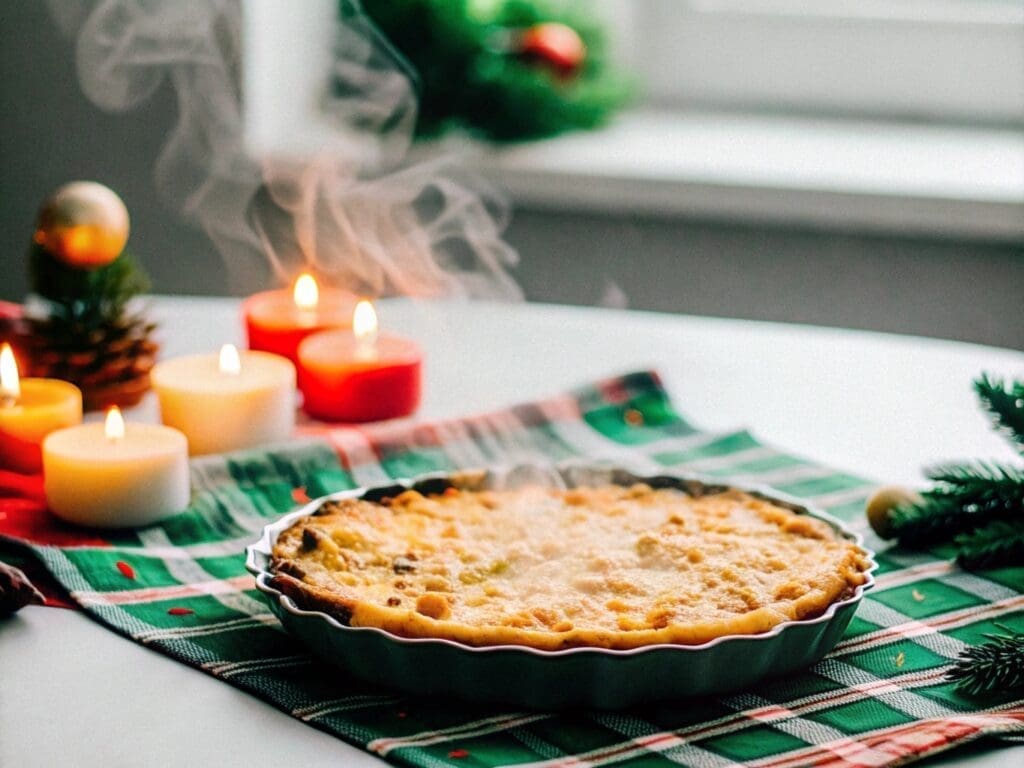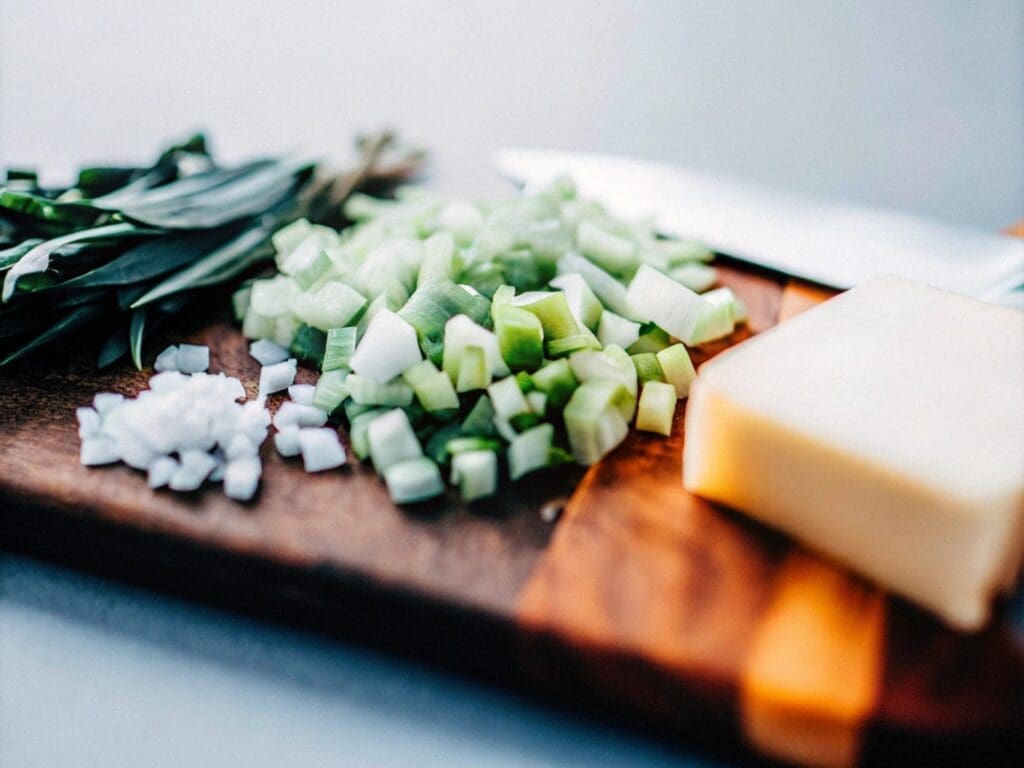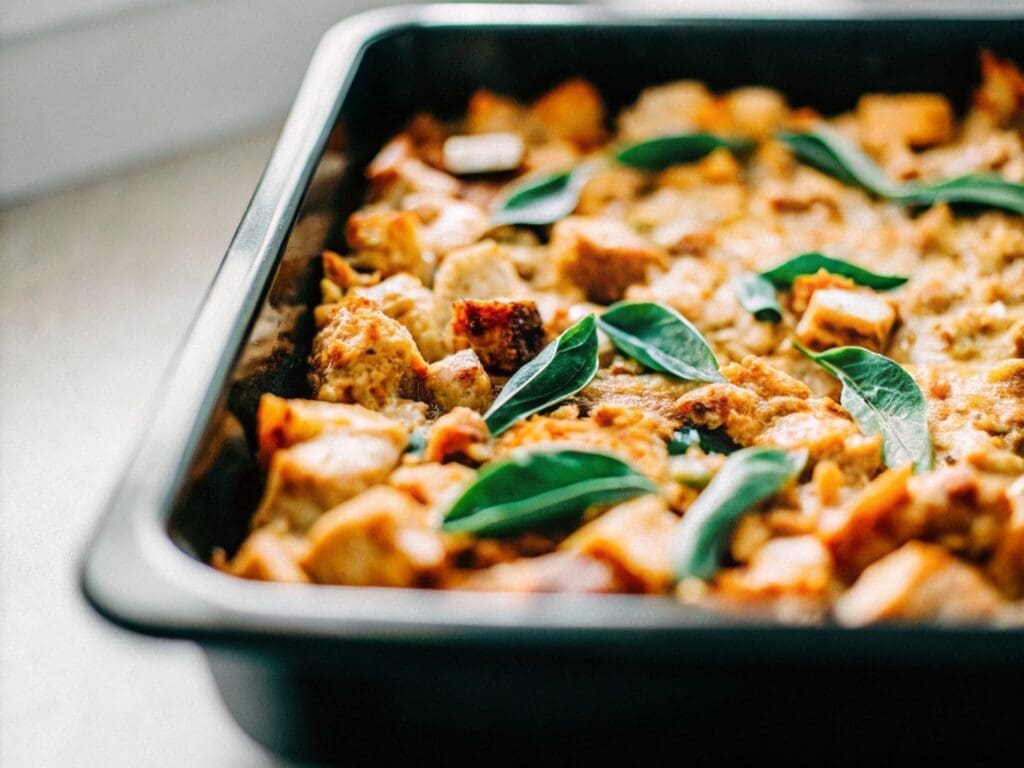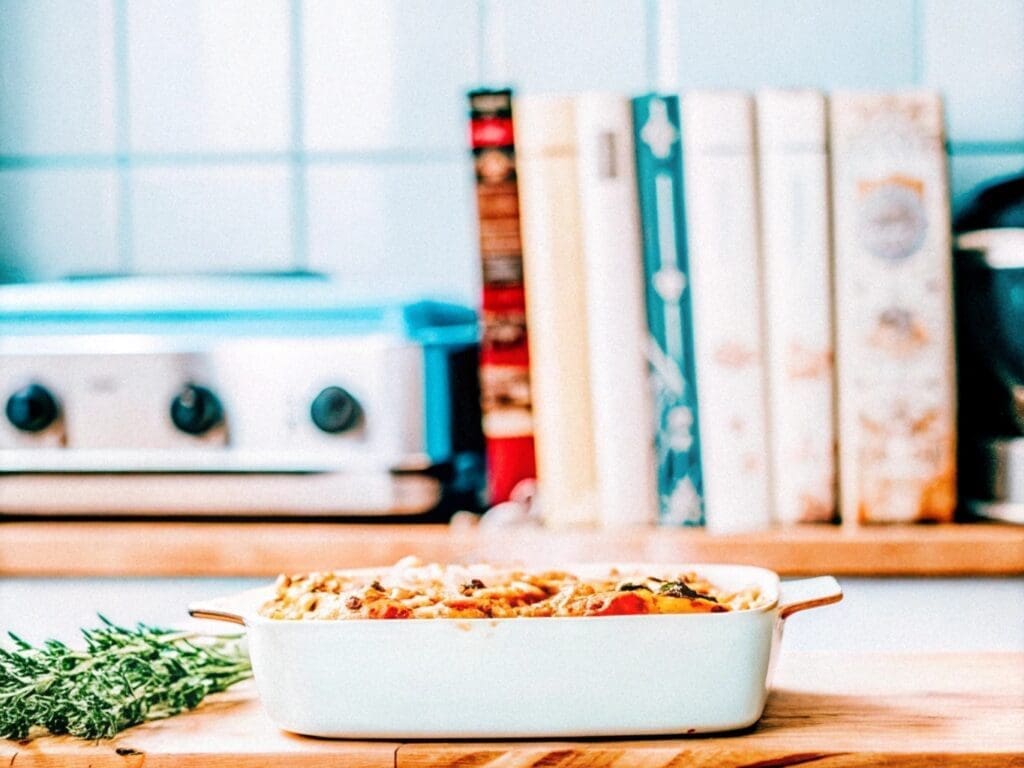Introduction
Have you ever wondered, what is chicken dressing made of? Whether you’re preparing for a big holiday feast or just craving a comforting side dish, chicken dressing is a staple in many homes. Its rich flavors and hearty texture make it the perfect accompaniment to roasted chicken, turkey, or even a vegetarian meal.
In this guide, we’ll break down everything you need to know about chicken dressing—from the traditional ingredients to some modern twists. By the end, you’ll not only understand its components but also feel ready to make it yourself!

Ingredients
Chicken dressing is a delightful combination of simple pantry staples and fresh ingredients. At its core, it’s all about combining a starchy base, flavorful seasonings, and some moisture to create a cohesive and delicious dish. Below is a table showcasing the typical ingredients used in a traditional chicken dressing recipe:
| Ingredient | Role in the Dish |
|---|---|
| Bread or Cornbread | Acts as the base; absorbs flavors and provides structure. |
| Chicken Broth | Adds moisture and infuses the dish with savory flavor. |
| Cooked Chicken | Optional but enhances the richness of the dish with protein. |
| Onion and Celery | Brings aromatic and textural contrast to the dressing. |
| Butter | Adds richness and helps sauté vegetables for depth of flavor. |
| Eggs | Binds the ingredients together for a cohesive texture. |
| Sage and Thyme | Classic herbs that give the dressing its signature taste. |
| Salt and Pepper | Essential seasonings to enhance all the other flavors. |
Ingredient Insights
- Bread or Cornbread:
The choice of bread dramatically affects the texture and taste of your dressing. Cornbread creates a crumbly, slightly sweet dressing, while regular white bread gives a soft and smooth consistency. Some recipes even use a mix of both for a balanced texture. - Chicken Broth:
Homemade broth often yields the most flavorful results, but store-bought works just fine. Opt for low-sodium broth so you can control the seasoning levels. - Butter and Aromatics:
Butter is essential for sautéing onions and celery, releasing their natural sweetness and aroma. This step builds the flavor foundation for the dressing. - Eggs:
These ensure that the dressing holds together as it bakes, giving it a rich, custard-like consistency. - Herbs:
Sage and thyme are traditional, but you can get creative with rosemary, parsley, or even a pinch of nutmeg.

Step-by-Step Instructions for Making Chicken Dressing
Now that you know the answer to what is chicken dressing made of, let’s dive into the preparation process. Making chicken dressing is easier than you might think, and with these step-by-step instructions, you’ll create a dish that’s bursting with flavor.
Step 1: Prepare the Bread Base
- Choose Your Bread: Select either cornbread, white bread, or a combination of both.
- Dry the Bread: If you’re using fresh bread, leave it out for a day or bake it at 200°F for 10-15 minutes until dry and slightly crisp. This helps the bread absorb moisture better.
- Crumble: Break the bread into small, uniform pieces and place them in a large mixing bowl.
For a complete recipe, check out our Chicken Dressing Recipe: Easy & Delicious.
Step 2: Cook the Aromatics
- Melt Butter: Heat 2-3 tablespoons of butter in a skillet over medium heat.
- Sauté Vegetables: Add finely diced onions and celery. Cook until softened, about 5-7 minutes, stirring occasionally.
- Season: Sprinkle in a pinch of salt, pepper, and your choice of herbs, such as sage and thyme. Stir well to combine.
Step 3: Combine the Ingredients
- Add Chicken Broth: Pour about 2-3 cups of warm chicken broth over the bread. Stir gently to moisten the bread without making it soggy.
- Mix in Cooked Chicken: Shred or dice cooked chicken (optional) and fold it into the mixture.
- Add Eggs: Beat 2-3 eggs in a small bowl and mix them into the dressing to bind the ingredients together.
Step 4: Adjust Seasonings
- Taste Test: At this stage, taste the mixture and adjust the salt, pepper, and herbs as needed.
- Optional Add-ins: For a twist, add ingredients like cranberries, pecans, or mushrooms to the mixture.
Step 5: Bake the Dressing
- Preheat Oven: Set your oven to 350°F (175°C).
- Prepare the Dish: Grease a baking dish with butter or nonstick spray and transfer the dressing mixture into it. Spread it evenly.
- Bake: Cover the dish with aluminum foil and bake for 30 minutes. Remove the foil and bake for another 15-20 minutes until the top is golden brown and slightly crispy.

Step 6: Serve and Enjoy
Let the chicken dressing rest for 5-10 minutes after baking. This allows the flavors to settle and makes it easier to serve. Pair it with roasted chicken, turkey, or even a hearty salad for a complete meal.
Cultural and Historical Context
Chicken dressing is more than just a side dish—it carries a rich history and deep cultural significance in various cuisines, particularly in the United States. Let’s explore where this beloved dish comes from and how it has evolved over time.
The Origins of Dressing
Chicken dressing finds its roots in traditional stuffing recipes from Europe. The concept of stuffing meat with seasoned bread dates back centuries and was commonly used to add flavor and stretch ingredients during times when resources were limited.
In the United States, stuffing evolved into “dressing” in the Southern states. This distinction is often attributed to regional terminology: “stuffing” is cooked inside a bird, while “dressing” is baked separately. Southern dressing is typically made with cornbread, which was readily available and inexpensive, making it a staple ingredient in the region’s cuisine.
Holiday Traditions
Dressing plays a central role in Thanksgiving and Christmas meals, especially in the South. It’s often paired with turkey, but chicken dressing has become equally popular for its hearty and versatile nature. Families pass down recipes from generation to generation, each adding their own twist, such as sausage, oysters, or unique herb blends.
Learn the key differences in our guide: What’s the Difference Between Stuffing and Dressing?.
Global Variations
While chicken dressing is quintessentially American, similar dishes exist worldwide:
- France: Bread stuffing with chestnuts and mushrooms is common in French cuisine.
- Middle East: Rice stuffing seasoned with spices like cinnamon and allspice is a popular alternative to bread-based dressings.
- Mexico: Cornbread stuffing seasoned with chiles and cilantro offers a spicy, vibrant variation.
These adaptations showcase the universal appeal of combining bread, seasonings, and aromatics to create a flavorful dish.

Creative Variations and Customizations
One of the best things about chicken dressing is its adaptability. Whether you’re looking to accommodate dietary restrictions, highlight seasonal flavors, or simply try something new, there’s no shortage of ways to customize this dish. Here are some creative ideas to inspire your next batch of chicken dressing.
1. Gluten-Free Chicken Dressing
For those avoiding gluten, traditional bread can be swapped with gluten-free alternatives. Consider these options:
- Gluten-Free Cornbread: Use a gluten-free cornbread mix to maintain the classic Southern flavor.
- Rice or Quinoa: Cooked rice or quinoa can replace the bread base for a grain-based dressing.
2. Vegetarian-Friendly Dressing
Skip the chicken and replace chicken broth with vegetable stock for a vegetarian version. You can bulk up the dish with plant-based protein or hearty vegetables:
- Chickpeas or Lentils: Add cooked chickpeas or lentils for texture and protein.
- Mushrooms: Sautéed mushrooms mimic the umami flavor of chicken.
3. Savory-Sweet Combinations
Introduce sweet elements to balance the savory flavors:
- Cranberries: Add dried or fresh cranberries for a tangy, fruity twist.
- Apples: Dice fresh apples for a subtle sweetness and crunch.
- Maple Syrup: Drizzle a little maple syrup over the dressing before baking for a caramelized finish.
4. Protein-Packed Additions
Make chicken dressing a complete meal by incorporating additional proteins:
- Sausage: Cooked, crumbled sausage adds a savory, spiced flavor.
- Bacon: Crispy bacon bits bring a smoky richness to the dish.
- Seafood: In coastal areas, oysters are a classic addition to dressing recipes.
5. Seasonal Herb Blends
While sage and thyme are traditional, experimenting with seasonal herbs can elevate the flavor:
- Spring: Use fresh parsley, chives, and dill for a lighter flavor.
- Fall: Incorporate rosemary and nutmeg for a warm, cozy taste.
6. Low-Carb Option
If you’re following a low-carb diet, consider these swaps:
- Cauliflower Rice: Replace the bread with cauliflower rice for a lighter, low-carb base.
- Almond Flour Biscuits: Use crumbled almond flour biscuits as a bread substitute.
7. Cheesy Indulgence
For a richer, more decadent dressing, add cheese:
- Cheddar: Sharp cheddar adds a bold flavor.
- Parmesan: A sprinkle of Parmesan on top creates a golden, crispy crust.
By customizing your chicken dressing with these ideas, you can create a dish that fits any occasion or personal preference.
Pair your dressing with a tangy twist from our Cranberry Sauce Pairings.
FAQs About Chicken Dressing
Here are answers to some of the most frequently asked questions about chicken dressing, ensuring you’re fully equipped to prepare and enjoy this classic dish.
1. What is chicken dressing made of?
Chicken dressing is made of a starchy base (like bread or cornbread), chicken broth, aromatics (onion and celery), butter, herbs (sage and thyme), eggs, and optional cooked chicken. These ingredients are combined and baked into a flavorful dish often served as a side.
2. Can I make chicken dressing ahead of time?
Yes! Chicken dressing is a perfect make-ahead dish. Prepare the mixture and store it in the refrigerator for up to 24 hours before baking. Alternatively, you can bake the dressing, cool it completely, and refrigerate or freeze it. Reheat it in the oven before serving.
3. What’s the difference between stuffing and dressing?
The main difference lies in how they’re cooked. Stuffing is cooked inside a bird (like chicken or turkey), while dressing is baked separately in a dish. The ingredients are often similar, but dressing allows for more control over texture and flavor.
4. How do I prevent my chicken dressing from becoming too dry?
To avoid dryness:
- Use enough chicken broth to moisten the bread without making it soggy.
- Cover the dish with foil during the first part of baking to retain moisture.
- Avoid overbaking; check the dressing after 30 minutes.
5. Can I make chicken dressing without eggs?
Yes, you can make egg-free chicken dressing! Use a substitute like flaxseed meal (1 tablespoon flaxseed meal mixed with 2.5 tablespoons water = 1 egg) or skip the eggs entirely if you prefer a looser texture.
6. What herbs can I use in chicken dressing?
Sage and thyme are traditional, but you can use rosemary, parsley, chives, or even oregano for a unique flavor profile. Experimenting with different herbs can add a fresh twist to your recipe.
Conclusion
Now that you know what chicken dressing is made of, you can confidently prepare this timeless dish for any occasion. From its simple, hearty ingredients to its rich history and versatile customizations, chicken dressing is a culinary treasure that’s easy to make and even easier to love. Whether you stick to the traditional recipe or experiment with creative twists, this dish is sure to be a crowd-pleaser.
Ready to try your hand at making chicken dressing? Gather your ingredients and bring this comforting classic to life in your kitchen. Don’t forget to share your version of the recipe with friends and family—it’s the kind of dish that brings everyone together. If you’re looking for more inspiration, check out our other recipes for side dishes and holiday favorites.
Happy cooking!

